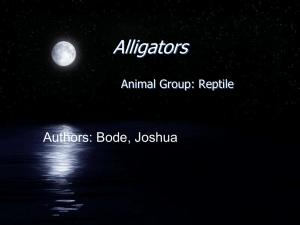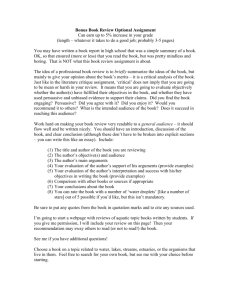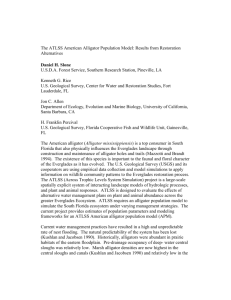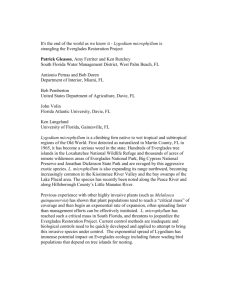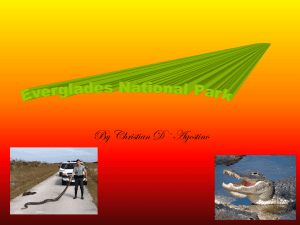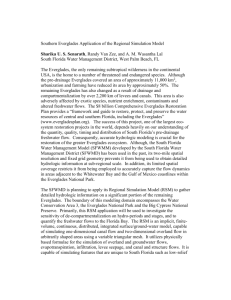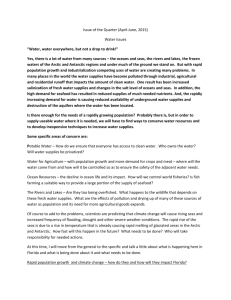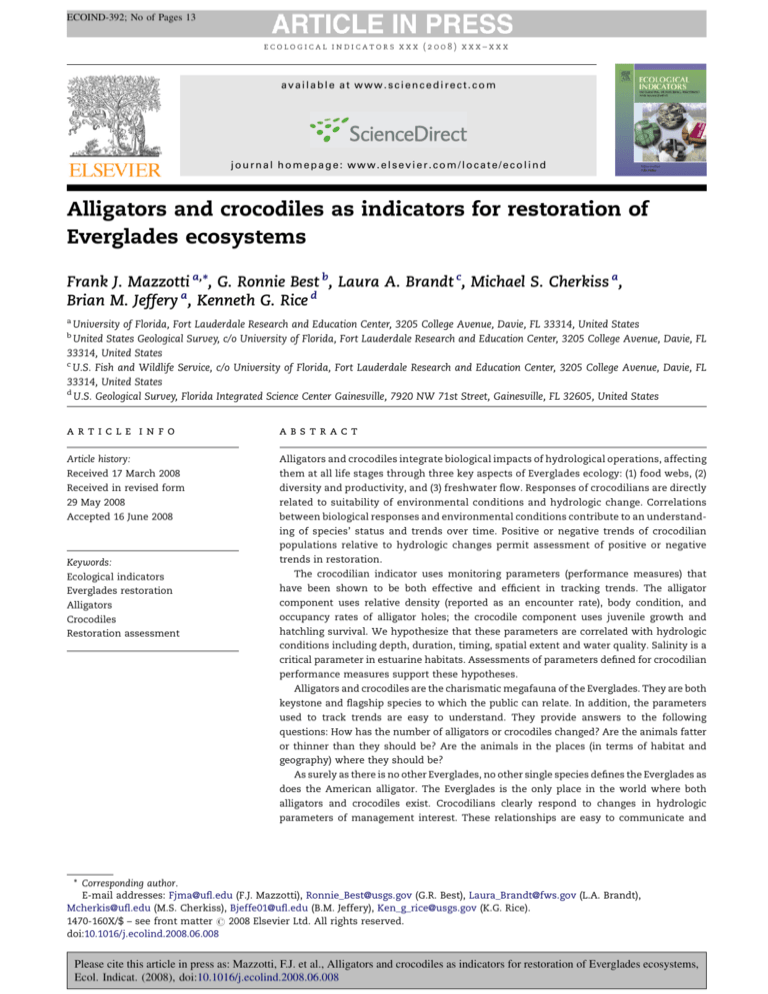
ECOIND-392; No of Pages 13
ecological indicators xxx (2008) xxx–xxx
available at www.sciencedirect.com
journal homepage: www.elsevier.com/locate/ecolind
Alligators and crocodiles as indicators for restoration of
Everglades ecosystems
Frank J. Mazzotti a,*, G. Ronnie Best b, Laura A. Brandt c, Michael S. Cherkiss a,
Brian M. Jeffery a, Kenneth G. Rice d
a
University of Florida, Fort Lauderdale Research and Education Center, 3205 College Avenue, Davie, FL 33314, United States
United States Geological Survey, c/o University of Florida, Fort Lauderdale Research and Education Center, 3205 College Avenue, Davie, FL
33314, United States
c
U.S. Fish and Wildlife Service, c/o University of Florida, Fort Lauderdale Research and Education Center, 3205 College Avenue, Davie, FL
33314, United States
d
U.S. Geological Survey, Florida Integrated Science Center Gainesville, 7920 NW 71st Street, Gainesville, FL 32605, United States
b
article info
abstract
Article history:
Alligators and crocodiles integrate biological impacts of hydrological operations, affecting
Received 17 March 2008
them at all life stages through three key aspects of Everglades ecology: (1) food webs, (2)
Received in revised form
diversity and productivity, and (3) freshwater flow. Responses of crocodilians are directly
29 May 2008
related to suitability of environmental conditions and hydrologic change. Correlations
Accepted 16 June 2008
between biological responses and environmental conditions contribute to an understanding of species’ status and trends over time. Positive or negative trends of crocodilian
populations relative to hydrologic changes permit assessment of positive or negative
Keywords:
Ecological indicators
trends in restoration.
The crocodilian indicator uses monitoring parameters (performance measures) that
Everglades restoration
have been shown to be both effective and efficient in tracking trends. The alligator
Alligators
component uses relative density (reported as an encounter rate), body condition, and
Crocodiles
occupancy rates of alligator holes; the crocodile component uses juvenile growth and
Restoration assessment
hatchling survival. We hypothesize that these parameters are correlated with hydrologic
conditions including depth, duration, timing, spatial extent and water quality. Salinity is a
critical parameter in estuarine habitats. Assessments of parameters defined for crocodilian
performance measures support these hypotheses.
Alligators and crocodiles are the charismatic megafauna of the Everglades. They are both
keystone and flagship species to which the public can relate. In addition, the parameters
used to track trends are easy to understand. They provide answers to the following
questions: How has the number of alligators or crocodiles changed? Are the animals fatter
or thinner than they should be? Are the animals in the places (in terms of habitat and
geography) where they should be?
As surely as there is no other Everglades, no other single species defines the Everglades as
does the American alligator. The Everglades is the only place in the world where both
alligators and crocodiles exist. Crocodilians clearly respond to changes in hydrologic
parameters of management interest. These relationships are easy to communicate and
* Corresponding author.
E-mail addresses: Fjma@ufl.edu (F.J. Mazzotti), Ronnie_Best@usgs.gov (G.R. Best), Laura_Brandt@fws.gov (L.A. Brandt),
Mcherkis@ufl.edu (M.S. Cherkiss), Bjeffe01@ufl.edu (B.M. Jeffery), Ken_g_rice@usgs.gov (K.G. Rice).
1470-160X/$ – see front matter # 2008 Elsevier Ltd. All rights reserved.
doi:10.1016/j.ecolind.2008.06.008
Please cite this article in press as: Mazzotti, F.J. et al., Alligators and crocodiles as indicators for restoration of Everglades ecosystems,
Ecol. Indicat. (2008), doi:10.1016/j.ecolind.2008.06.008
ECOIND-392; No of Pages 13
2
ecological indicators xxx (2008) xxx–xxx
mean something to managers, decision makers, and the public. Having crocodilians on the list
of system-wide, general indicators provides us with one of the most powerful tools we have to
communicate progress of ecosystem restoration in Greater Everglades ecosystems to diverse
audiences.
# 2008 Elsevier Ltd. All rights reserved.
1.
Introduction and background
Ecological monitoring is a key part of adaptive management
(Lovett et al., 2007; Williams et al., 2007) and successful
restoration. Not everything within an ecosystem can be
monitored so it is important to select indicators that are
representative of the system, integrate system responses,
show clear responses to system change, can be effectively and
efficiently monitored, and are easily communicated (Schiller
et al., 2001; Doren, 2006; Doren et al., in this issue).
Crocodilians (alligators and crocodiles) are one of the
indicators that meet these criteria within the Everglades
ecosystems. Restoration of hydrology is a major part of the
Comprehensive Everglades Restoration Plan (CERP; U.S. Army
Corps of Engineers, 1999), and indicators used for tracking
progress of Everglades restoration should have clear relationships to hydrologic conditions (U.S. Army Corps of Engineers,
2004; Doren et al., in this issue).
Alligators and crocodiles integrate biological impacts of
hydrological operations, affecting them at all life stages
(Mazzotti and Brandt, 1994; Mazzotti, 1999; Rice et al., 2005;
Mazzotti et al., 2007) through three key aspects of Everglades
ecology: (1) Food webs: Top predators such as crocodilians are
dependent on prey density, especially aquatic and semi-aquatic
organisms (Barr, 1997). Crocodilians are critical in the food web
as top predators, influencing abundance and composition of
prey (Mazzotti and Brandt, 1994). (2) Diversity and productivity:
Drier (nests) and wetter (trails and holes) conditions created by
ecosystem engineers like alligators provide habitat for plants
and animals that otherwise would not be able to survive. This
variation in hydrologic conditions created by alligators
increases diversity and productivity of Everglades marshes
(Kushlan and Kushlan, 1980; Campbell and Mazzotti, 2004;
Palmer and Mazzotti, 2004). (3) Freshwater flow: The distribution and abundance of crocodilians in estuaries is directly
dependent on timing, amount, and location of freshwater flow
(Dunson and Mazzotti, 1989; Mazzotti and Dunson, 1989). The
American crocodile, a flagship federally threatened species,
represents the importance of freshwater inflow to estuarine
health and productivity (Mazzotti et al., 2007).
Responses of crocodilians are directly related to suitability
of environmental conditions and hydrologic change (Mazzotti
and Brandt, 1994; Rice et al., 2005; Mazzotti et al., 2007).
Correlations between biological responses and environmental
conditions contribute to an understanding of species’ status
and trends over time. Positive or negative trends of crocodilian
populations relative to hydrologic changes permit assessment
of positive or negative trends in restoration. Restoration
success or failure can be evaluated by comparing recent and
future trends and status of crocodilian populations with
historical or reference population data and model predictions,
as stated in the CERP hypotheses related to alligators and
crocodiles (U.S. Army Corps of Engineers, 2004, Sections 3.1.2.5
and 3.1.2.6).
The crocodilian indicator uses monitoring parameters
(performance measures) that have been shown to be both
effective and efficient in tracking trends (Mazzotti and
Cherkiss, 2003; Rice and Mazzotti, 2006). The alligator
component uses relative density (reported as an encounter
rate), body condition, and occupancy rates of alligator holes;
the crocodile component uses juvenile growth and hatchling
survival. We hypothesize that these parameters are correlated
with hydrologic conditions including depth, duration, timing,
spatial extent and water quality. Salinity is a critical parameter
in estuarine habitats (Dunson and Mazzotti, 1989; Mazzotti
and Dunson, 1989).
Alligators and crocodiles are the charismatic megafauna of
the Everglades. They are both keystone and flagship species to
which the public can relate. In addition, the parameters used
to track trends are easy to understand. They provide answers
to the following questions: How has the number of alligators
or crocodiles changed? Are the animals fatter or thinner than
they should be? Are the animals in the places (in terms of
habitat and geography) where they should be?
1.1.
CERP hypotheses for crocodilians
A system-wide monitoring and assessment plan (MAP) has
been developed that describes the monitoring necessary to
track ecological responses to Everglades restoration (U.S.
Army Corps of Engineers, 2004). The plan includes descriptions of selected indicators, how those indicators are linked to
key aspects of restoration (hypotheses), and performance
measures.
The MAP poses three hypotheses for alligators: (1)
Restoration of hydropatterns (depth, duration, distribution,
and flow) in Southern Marl Prairies/Rocky Glades will expand
the distribution and abundance of reproducing alligators and
active alligator holes and restore the keystone role of alligator
holes as refugia for aquatic fauna; (2) Restoration of estuarine
salinity regimes will expand the distribution and abundance of
reproducing alligators into oligohaline portions of estuaries;
and (3) Restoration of hydropatterns in ridge and slough
landscape will sustain current populations of reproducing
alligators. The MAP hypothesis for crocodiles is that restoration of freshwater flows to estuaries and salinity regimes will
increase growth and survival of crocodiles.
1.2.
Areas of the Everglades this indicator covers
Crocodilians are present throughout virtually all Everglades
freshwater wetlands and estuarine areas (Fig. 1). These
Please cite this article in press as: Mazzotti, F.J. et al., Alligators and crocodiles as indicators for restoration of Everglades ecosystems,
Ecol. Indicat. (2008), doi:10.1016/j.ecolind.2008.06.008
ECOIND-392; No of Pages 13
ecological indicators xxx (2008) xxx–xxx
Fig. 1 – Areas important to monitoring and assessment of alligators and crocodiles in South Florida.
Please cite this article in press as: Mazzotti, F.J. et al., Alligators and crocodiles as indicators for restoration of Everglades ecosystems,
Ecol. Indicat. (2008), doi:10.1016/j.ecolind.2008.06.008
3
ECOIND-392; No of Pages 13
4
ecological indicators xxx (2008) xxx–xxx
areas include the following Restoration Coordination Verification of Everglades Restoration (RECOVER) & Science
Coordination Group (SCG) regional modules: Greater Everglades, Florida Bay and Southern Estuaries, Big Cypress,
Lake Okeechobee, and the Kissimmee River Basin. Crocodilians are included as attributes in the following conceptual ecological models: Total System, Everglades Ridge
and Slough, Southern Marl Prairies (Rocky Glades), Everglades Mangrove Estuaries, and Biscayne Bay. A systemwide monitoring and assessment plan has been developed
for alligators and crocodiles that includes the Arthur R.
Marshall Loxahatchee National Wildlife Refuge (LNWR)
which includes Water Conservation Area 1, Water Conservation Areas 2 and 3 (WCA 2 and WCA 3), Everglades
National Park (ENP), the Biscayne Bay complex, and Big
Cypress National Preserve (Fig. 1). We sample for relative
density and body condition of alligators in canals and
marshes in LNWR, WCA 2A, WCA 3A and 3B; and canals,
marshes and estuaries in ENP. Occupancy of alligator holes
is sampled in Northeast Shark Slough, Rocky Glades, and
Southern Marl Prairies (Fig. 1). Crocodiles are sampled
throughout the southern mangrove estuaries (Fig. 1).
1.3.
Indicator history
The significance of the crocodilian indicator relates to alligators’
roles as top predator, keystone species and ecosystem engineer,
and crocodiles’ roles as top predator, flagship species and
threatened species. Reproduction, growth, and survival of
crocodilians are dependent on food availability—birds, mammals, fish, reptiles, amphibians, and macroinvertebrates—that
in turn is dependent on hydrologic conditions. Loss of flow and
relatively dry hydrologic conditions resulting from water
management over the past several decades, and a loss of
habitat (due partly to reduced areas of inundation, increased
drydowns, and increased salinization) in the Everglades have
adversely affected alligators and crocodiles (Mazzotti and
Brandt, 1994; Rice et al., 2005; Mazzotti et al., 2007). Loss of
habitat in Southern Marl Prairies and Rocky Glades and changes
in hydropatterns (reduction in depth and period of inundation)
of remaining areas have reduced abundance of alligators and
alligator holes in these habitats (Craighead, 1968). Reduced prey
availability throughout the system as a result of hydrologic
alterations corresponds with lower growth, survival, and
reproduction of alligators and crocodiles (Mazzotti and Brandt,
1994; Mazzotti et al., 2007).
Both alligators and crocodiles have been affected by loss of
freshwater flow to estuaries. This loss of flow corresponds to a
reduction in distribution and abundance of alligators (Craighead, 1968). Although there are more crocodiles in more places
today than when they were declared endangered, virtually all of
the increase is due to crocodiles occupying and nesting in manmade habitats such as the Turkey Point Power Plant site
(Mazzotti and Cherkiss, 2003). The mangrove back-country of
northeastern Florida Bay has always been considered as core
habitat of the American crocodile in Florida (Kushlan and
Mazzotti, 1989; Mazzotti, 1999). Today this physically unaltered
area suffers from diversion of freshwater (McIvor et al., 1994).
This area also has the lowest rates of growth and survival of
crocodiles anywhere in Florida (Mazzotti et al., 2007).
Because of its unique geographic location and subtropical
climate, South Florida is the only place in the world where
both alligators and crocodiles occur. The most important
regional factors affecting distribution and abundance of these
crocodilians are loss of habitat (including extent of areas
inundated for both species and nesting habitat for crocodiles),
hydroperiod, water depth, and salinity (Mazzotti and Brandt,
1994; Mazzotti, 1999; Mazzotti and Cherkiss, 2003; Rice et al.,
2005). Water management has changed the pattern of water
levels in the southern Everglades, causing unnatural flooding
events and failure of alligator nests (Kushlan and Jacobsen,
1990). Increasing drought frequency and depth of drying have
reduced suitability of Southern Marl Prairie and Rocky Glades
habitats and occupancy of alligator holes by alligators.
Increasing drought frequency and depth of drying also
increase the time required for fish and macroinvertebrate
populations to recover to levels considered representative of
the historical Everglades (Trexler et al., 2003; Trexler and Goss,
in this issue). When drying events occur repeatedly at less
than a three-to-eight-year interval, fish and macroinvertebrate populations are continually recovering from past
droughts and may fail to reach densities sufficient to sustain
large predators such as alligators (Loftus and Eklund, 1994;
Turner et al., 1999; Trexler et al., 2005). This is correlated with
lower growth and reproductive rates for alligators in the
Everglades when compared to other parts of their range
(Mazzotti and Brandt, 1994). Repeated drying events also may
wipe out entire age classes, as alligators are forced to
congregate in remaining water bodies where they may suffer
predation and cannibalism.
Water salinity also affects populations of crocodilians
(Dunson and Mazzotti, 1989; Mazzotti and Dunson, 1989).
Although American crocodiles are more tolerant of salt water
than alligators, both species prefer fresh to brackish water
(Mazzotti, 1983). The distribution of alligators in estuaries has
been affected by intrusion of salt water (Craighead, 1968;
Mazzotti and Brandt, 1994). In northeastern Florida Bay, the
occurrence of alligators corresponds with the presence of
freshwater (Mazzotti, 1983). Regionally, lack of freshwater has
been correlated with lower growth and survival of crocodiles
(Moler, 1992; Mazzotti and Cherkiss, 2003; Mazzotti et al., 2007).
In a particularly encouraging finding, Mazzotti et al. (2007)
reported that after Buttonwood and East Cape canals in
Everglades National Park were plugged in the 1980s to reduce
saltwater intrusion into interior areas of Whitewater Bay and
Cape Sable, crocodiles responded positively by increasing
nesting effort and success. This suggests that restoring
salinity patterns in estuaries can have a positive effect on
this indicator and that monitoring is effective at determining
population responses. It also indicates that nesting effort and
success should be added to growth and survival as monitoring
parameters.
Models of different levels of complexity have been and are
being developed using crocodilians as indicators for evaluation and assessment of hydrological alternatives. The Across
Trophic Level Spatial Simulation (ATLSS) Spatially Explicit
Suitability Index (SESI) alligator model simulates probability of
alligator reproduction across the southern Everglades landscape based on hydrological drivers (http://www.atlss.org). A
simple salinity suitability model was developed to evaluate
Please cite this article in press as: Mazzotti, F.J. et al., Alligators and crocodiles as indicators for restoration of Everglades ecosystems,
Ecol. Indicat. (2008), doi:10.1016/j.ecolind.2008.06.008
ECOIND-392; No of Pages 13
5
ecological indicators xxx (2008) xxx–xxx
Table 1 – Decision rule questions for forming performance measure/suitability relationships for the crocodilian indicator
communication tool
Alligator questions
1. What is the current relative density for the American alligator (mean non-hatchling, >50 cm, animals per km during spring of reporting survey
year) by management unit in South Florida?
a.
0–1.47
Score: 0
Red
b.
1.48-2.70
Score: 0.50
Yellow
c.
>2.71
Score: 1.0
Green
2. What is the mean relative density for the American alligator (five-year running mean of non-hatchling, >0.50 cm, animals per km) by
management unit in South Florida?
a.
0–1.47
Score: 0
Red
b.
1.48–2.70
Score: 0.50
Yellow
c.
>2.71
Score: 1.0
Green
3. What is the most recent trend in relative density for the American alligator by management unit in South Florida?
a.
Slope
Score: 0
b.
Stable
Score: 0.5
c.
+Slope
Score: 1.0
Red
Yellow
Green
4. What is the current body condition for the American alligator (lowest spring or fall mean condition during reporting survey year) by
management unit in South Florida?
a.
0–9.31
Score: 0
Red
b.
9.32–11.27
Score: 0.50
Yellow
c.
>11.28
Score: 1.0
Green
5. What is the mean body condition for the American alligator (three-year running mean) by management unit in South Florida?
a.
0–9.31
Score: 0
b.
9.32–11.27
Score: 0.50
c.
>11.28
Score: 1.0
Red
Yellow
Green
6. What is the most recent trend in body condition for the American alligator by management unit in South Florida?
a.
Slope
Score: 0
b.
Stable
Score: 0.5
c.
+Slope
Score: 1.0
Red
Yellow
Green
7. What is the current percentage of occupancy of alligator holes in Everglades National Park?
a.
0–40
Score: 0
b
>40–80
Score: 0.60
c.
>80–100
Score: 1.0
Red
Yellow
Green
Crocodile questions
8. What is the current growth of juvenile crocodiles (75 cm) in cm/day by management unit in South Florida during reporting year?
a.
0–0.068
Score: 0
b.
>0.068–0.15
Score: 0.50
c.
>0.15
Score: 1.0
Red
Yellow
Green
9. What is the mean growth of juvenile crocodiles (75 cm) in cm/day by management unit in South Florida (three-year running mean)?
a.
0–0.068
Score: 0
Red
b.
>0.068–0.15
Score: 0.50
Yellow
c.
>0.15
Score: 1.0
Green
10. What is the most recent trend in growth of juvenile crocodiles (75 cm) in cm/day by management unit in South Florida?
a
Slope
Score: 0
b.
Stable
Score: 0.5
c.
+Slope
Score: 1.0
Red
Yellow
Green
11. What is the current survival of hatchling crocodiles (mean monthly fall survival during reporting year) by management unit in South Florida
during reporting year?
a.
0–0.64
Score: 0
Red
b.
>0.64–0.85
Score: 0.50
Yellow
c.
>0.85
Score: 1.0
Green
12. What is the mean survival of hatchling crocodiles by management unit in South Florida (five-year running mean of monthly survival during
fall of hatch year)?
a.
0–0.64
Score: 0
Red
b.
>0.64–0.85
Score: 0.50
Yellow
c.
>0.85
Score: 1.0
Green
13. What is the most recent trend in survival of hatchling crocodiles by management unit in South Florida?
a.
Slope
Score: 0
b.
Stable
Score: 0.5
c.
+Slope
Score: 1.0
Red
Yellow
Green
A score of 1.0 for a performance measure is the restoration target.
Please cite this article in press as: Mazzotti, F.J. et al., Alligators and crocodiles as indicators for restoration of Everglades ecosystems,
Ecol. Indicat. (2008), doi:10.1016/j.ecolind.2008.06.008
ECOIND-392; No of Pages 13
6
ecological indicators xxx (2008) xxx–xxx
water deliveries to Taylor Slough/C-111 (Mazzotti and Brandt,
1995). More sophisticated models are being developed for both
species. An alligator production model has been developed
that combines the alligator SESI model with functions for
growth, dispersal, and survival to produce forecasts for
nesting and relative density suitable for assessment of
hydrological alternatives (Slone et al., 2003). Development of
a similar crocodile model is underway.
1.4.
Significance of the indicator to Everglades restoration
1.4.1. The indicator is relevant to the Everglades ecosystem
and responds to variability at a scale that makes it applicable
to the entire ecosystem or large or small portions of the
ecosystem
Alligators and crocodiles cover the entire spatial extent of
Greater Everglades ecosystems and are characteristic of all
Everglades freshwater and estuarine wetlands. They are top
predators that affect prey populations of all sizes; productivity
of populations and growth, survival, and body condition of
individuals can be directly linked to hydrology (Dalrymple,
1996; Barr, 1997; Mazzotti et al., 2007). Alligators are a keystone
species and ecosystem engineers. By constructing nests, trails
and holes, they provide drier and wetter conditions for species
of plants and animals that otherwise would not be able to
survive (Craighead, 1968; Campbell and Mazzotti, 2004; Palmer
and Mazzotti, 2004). Crocodiles are a flagship species for
southern estuaries, representing the importance of restoring
freshwater flow. Population measures for both species
(relative density and body condition of alligators, occupancy
of alligator holes, and growth and survival of crocodiles) are
key outcomes (performance measures) in RECOVER Conceptual Ecological Models and in CERP Interim Goals. These
performance measures vary at a local scale among Everglades
management areas (Rice and Mazzotti, 2006). Hence, the
crocodilian indicator can be used to compare responses of
different management units as well as the entire system.
1.4.2. The indicator is feasible to implement and is
scientifically defensible
There are well-established methods for tracking the performance measures (Mazzotti and Cherkiss, 2003; Rice and
Mazzotti, 2006) and there are both long- and short-term
databases covering over 25 years for some parameters. These
databases and expert opinion have been combined to create
models to evaluate impacts of water management on this
indicator (Mazzotti and Brandt, 1995; Slone et al., 2003). These
databases and models are being improved through cooperative research, modeling, and monitoring projects with University of Florida, United States Geological Survey, United
States Fish and Wildlife Service, United States National Park
Service, United States Army Corps of Engineers, and Florida
Fish and Wildlife Conservation Commission. This indicator is
already included in the CERP RECOVER interim goals and Food
Web Monitoring Component of the CERP MAP.
1.4.3. The indicator is sensitive to system drivers (stressors)
and integrative of system components
Key hydrological drivers/stressors (e.g., rainfall, hydropattern,
and salinity) are hypothesized to be correlated to species
distribution, abundance, body condition, growth, and survival.
Distribution and abundance of crocodilians in estuaries is
limited by freshwater (Dunson and Mazzotti, 1989; Mazzotti
and Dunson, 1989). Nesting of alligators and crocodiles has
been statistically correlated with regional hydrological conditions (Kushlan and Jacobsen, 1990; Ugarte, 2006). As top
predators in the Everglades, crocodilians integrate productivity throughout the trophic web; improvement in alligator
populations will result in more aquatic refugia (alligator holes
and trails) for all aquatic species in the system.
2.
Communicating the crocodilian indicator
The crocodilian indicator consists of three performance
measures for the alligator component and two performance
measures for the crocodile component.
2.1.
Indicator performance measures and metrics
The performance measures for the alligator component are
relative density (reported as an encounter rate, number per
kilometer), body condition (Fulton’s K), and occupancy rates
(percent occupied) of alligator holes in the Southern Marl
Prairies/Rocky Glades in Everglades National Park. The
performance measures for the crocodile indicator are juvenile
growth (cm per day total length for crocodiles 75 cm) and
survival (% monthly survival) of hatchling crocodiles in fall
(August–December).
CERP RECOVER targets for crocodilian metrics are based on
patterns that we consider natural for Everglades ecosystems,
rather than a maximum or optimal value for a species. For
example, alligators grow faster, get fatter (even obese), and
have greater densities in nutrient-enriched open water
systems than oligotrophic Everglades marsh and swamp
ecosystems. Our targets take into consideration that Everglades alligators should grow more slowly, be more slender,
and have lower relative densities than alligators in other areas
such as central Florida. Maximizing or optimizing targets for
single species is likely to be detrimental to maintaining species
assemblages characteristic of the Greater Everglades.
2.2.
The stoplight restoration report card system applied to
crocodilians
This communication tool is based on MAP performance
measures (either by module or system-wide) and is expected
to be able to distinguish between responses to restoration and
natural patterns. A set of questions (decision rules; Table 1)
has been developed for each performance measure. Answers
are translated as suitability indices and colors (Table 2). Two
questions are addressed using suitability indices: (1) have we
reached the restoration target, or if not, (2) are we making
progress toward targets? Finally, results are translated into a
stoplight display.
Because performance measures and knowledge of performance measures vary among indicators, methods for producing suitability curves will vary among performance
measures. For example, a five-year running average was used
for mean relative density, where expected power to detect
Please cite this article in press as: Mazzotti, F.J. et al., Alligators and crocodiles as indicators for restoration of Everglades ecosystems,
Ecol. Indicat. (2008), doi:10.1016/j.ecolind.2008.06.008
ECOIND-392; No of Pages 13
ecological indicators xxx (2008) xxx–xxx
Table 2 – Translation table for converting suitability or
trend index for a performance measure or indicator into
an index score and stoplight color
Index range
0.0–0.4
>0.4–0.8
>0.8–1.0
Index score
0
0.5
1.0
Stoplight color
Red
Yellow
Green
changes should enable trends to be detected in three to five
years. A three-year running average was used for mean body
condition where expected power should enable trends to be
detected in one to three years. For most crocodilian performance measures, we used empirical data from reference sites
as explained below (Rice and Mazzotti, 2006). The exception
was occupancy rate of alligator holes, in which case the upper
limit of the parameter was based on historical information
(Craighead, 1968). Both targets and shapes of curves can be
modified as more is learned about an indicator.
The trend for each performance measure is determined by
plotting the mean score for the past five years. If the trend
(slope) is negative the index score is 0, if the performance
measure has remained the same the index score is 0.5, and if
the trend is positive the score is 1.0.
2.3.
card
Metrics for the crocodilian stoplight restoration report
2.3.1.
Alligator relative density
Values for relative density were developed by plotting
frequency of relative density (mean non-hatchling, >50 cm
total length (TL), alligators per km) across all survey routes
(Fig. 2A; individual replicates of 10 areas over four to eight
years) developed through the Alligator MAP night surveys,
1999–2006 (Rice and Mazzotti, 2006). We examined the data
through use of quartiles and known relative densities of
alligators in the Everglades and in central Florida (A.R.
Woodward, unpublished data) for comparison.
Stoplights were developed by division along quartiles based
on surveys conducted in the Everglades system only. Based on
these divisions, for annual assessments, we evaluated the
current relative density (mean of the two spring replicates
within the reporting year), mean relative density (five-year
running average of all replicates), and the most recent trend in
relative density as in Table 1. Assessments were performed by
individual management unit throughout the Everglades
system (LNWR, WCA 2A, WCA 3A North, WCA 3A Central,
WCA 3A South, WCA 3B, ENP—Northeast Shark Slough, ENP—
Shark Slough, and ENP—Estuarine).
2.3.2.
Alligator body condition
We used the distribution of body condition (Fulton’s K)
(Zweig, 2003) of all alligators captured and assessed during
Alligator MAP monitoring, 1999–2006 (Rice and Mazzotti,
2006) to establish stoplight criteria for alligator body
condition (n = 1755; Fig. 2B). We examined the data through
use of quartiles and known body condition of alligators in
the Everglades, and compared it to alligators in South
Carolina (P.M. Wilkinson, unpublished data) and central
Florida (A.R. Woodward, unpublished data). Stoplights were
7
developed by division along quartiles based on animals
captured in the Everglades system only. Based on these
divisions, for the annual assessments, we assigned scores to
the current body condition (lowest mean of fall (n = 15) and
spring (n = 15) captures within the reporting year; Fig. 2B),
mean body condition (three-year running average of all
captures), and the most recent trend as in Table 1.
Assessments were performed by individual management
unit as above.
2.3.3.
Alligator hole occupancy
Alligator holes occur throughout the Everglades landscape.
Natural peat ponds in central ridge and slough wetlands do not
have an underlying depression in the limestone bedrock, are
not fixed features in the landscape, and can be created when
an alligators needs access to the water table (Campbell and
Mazzotti, 2004). In contrast, alligator holes in the marl prairies
and Rocky Glades of the southern Everglades occur in
depressions in the bedrock, are fixed in the landscape, and
are maintained, but not created, by alligators (Craighead, 1968;
Kushlan and Hunt, 1979). For that reason the alligator hole
occupancy metric is only applied to southern Everglades
wetlands.
We used the mean proportion of alligator holes occupied by
at least one alligator as an index to occupancy of alligator holes
in 2005–2006 (Rice and Mazzotti, 2006). We were unable to use
the quartile approach or any more elaborate methodology to
develop stoplight criteria for this component due to lack of
data. Under MAP, we only assessed alligator hole occupancy
during 2005–2006 in ENP. We also have results from surveys of
alligator holes in WCA 3 by Campbell and Mazzotti (2004) as
well as some historical information from Craighead (1968). We
used a frequency diagram of all measures of occupancy from
ENP during 2005–2006 along with the historical information to
make determinations of stoplight divisions by breaks in the
distribution (Fig. 2C). Based on these divisions, for the annual
assessments, we assigned a score to the current occupancy
(mean occupancy across all surveys within the reporting year)
as in Table 1 for ENP. This component is applicable to areas of
Northeast Shark Slough, Rocky Glades, and Southern Marl
Prairies.
2.4.
Crocodile juvenile growth
We used the distribution of all crocodiles captured and
measured during studies conducted from 1978–2006 (n = 498;
Mazzotti et al., 2007) to establish stoplight criteria for crocodile
juvenile growth. Juveniles were defined as animals 75 cm
total length (TL). Growth was measured in cm per day over the
longest period between captures for animals recaptured at
least once between hatching and 75 cm TL (Fig. 3A). We
examined the data through the use of quartiles. Stoplights
were developed by division along quartiles based on all
animals captured in Everglades National Park and the
Biscayne Bay complex. For annual assessments, we assigned
scores to current crocodile juvenile growth (animals captured
within the reporting year), mean growth (five-year running
average of all captures), and the most recent trend as in
Table 1. Assessments were performed by individual management unit (ENP and Biscayne Bay complex).
Please cite this article in press as: Mazzotti, F.J. et al., Alligators and crocodiles as indicators for restoration of Everglades ecosystems,
Ecol. Indicat. (2008), doi:10.1016/j.ecolind.2008.06.008
ECOIND-392; No of Pages 13
8
ecological indicators xxx (2008) xxx–xxx
Fig. 2 – Alligator components used to determine stoplight thresholds for (A) distribution of night-light surveys of alligators in
the Everglades of South Florida (1999–2006) used to determine relative density; (B) distribution of all alligators captured and
Please cite this article in press as: Mazzotti, F.J. et al., Alligators and crocodiles as indicators for restoration of Everglades ecosystems,
Ecol. Indicat. (2008), doi:10.1016/j.ecolind.2008.06.008
ECOIND-392; No of Pages 13
ecological indicators xxx (2008) xxx–xxx
9
Fig. 3 – Crocodile components used to determine stoplight thresholds for (A) distribution of all growth rates of juvenile
American crocodiles captured in South Florida, 1978–2006; and (B) monthly survival (%) of American crocodile hatchlings in
Everglades National Park (ENP), Biscayne Bay complex (BB), and Northern Key Largo (NKL) from 1978–2006. Two separate
analyses were used: Minimum Known Alive (Mazzotti et al., 2007) and multi-state (size class T management unit) capturerecapture survival analyses (Nichols and Kendall, 1995).
2.4.1.
Crocodile hatchling survival
We established stoplight criteria for crocodile hatchling
survival during the critical fall (August–December) posthatching period (Mazzotti, 1983) by two methods. First, we
used the Minimum Known Alive analysis of Mazzotti et al.
(2007) to develop a range of possible survival probabilities
(Fig. 3B). Second, we performed multi-state (size class manmanagement unit) capture-recapture survival analyses
(Nichols and Kendall, 1995) of all captures (n = 3981) from
1978–2004 using Program Mark (White and Burnham, 1999).
The best model of fall hatchling survival included a management unit effect, a period effect (dry years vs. wet years), and a
management unit period interaction (Fig. 3B). This model
had an Akaike weight of 0.96, indicating very strong support
(Burnham and Anderson, 2002). Stoplights were developed by
division along the mean estimates of survival from the above
assessed for body condition in the Everglades of South Florida, 1999–2006 (n = 1755); and (C) distribution of all surveys of
alligator hole occupancy in the Everglades of South Florida (2005–2006) and historical evidence (Craighead, 1968; Campbell
and Mazzotti, 2004).
Please cite this article in press as: Mazzotti, F.J. et al., Alligators and crocodiles as indicators for restoration of Everglades ecosystems,
Ecol. Indicat. (2008), doi:10.1016/j.ecolind.2008.06.008
ECOIND-392; No of Pages 13
10
ecological indicators xxx (2008) xxx–xxx
analyses (Fig. 3B). Based on these divisions, for the annual
assessments, we assigned scores to current crocodile hatchling survival (survival within the reporting year), mean
hatchling survival (five-year running average of survival)
and the most recent trend as in Table 1. Assessments were
performed by individual management unit as above.
2.5.
card
Scoring the crocodilian stoplight restoration report
2.5.1.
Alligator component score
The assigned component score was the mean of associated
performance measures (e.g., current relative density, mean
relative density, and trend in relative density).
2.5.2.
Alligator management unit score
For each management unit, we assigned a score based on the
mean of the component scores for relative density, body
condition, and, where appropriate, hole occupancy.
sures. The communication tool has been designed to
distinguish between effects of restoration projects and natural
phenomena. Targets for performance measures are established from historical data or reference sites. For crocodilians,
we generally assigned the lower quartiles (below the median
values) of possible distributions of parameters as the areas
associated with caution and failure. By using spatially
referenced suitability indices, the indicator communication
tool can be linked directly to evaluation processes for
restoration assessments. The communication tool instantly
conveys the status of the indicator, whereas trend curves
provide information on progress towards reaching a target.
This indicator communication tool has the advantage that it
can be applied regionally, by species, and collectively systemwide. Importantly, both targets and suitability curves can be
adapted as science improves our understanding of crocodilians in the Greater Everglades ecosystems.
3.
2.5.3.
We defined the system-wide alligator score as the geometric
mean of the management unit scores. We did this to
emphasize any management unit that scored exactly 0 and
would necessitate immediate management consideration.
2.5.4.
Crocodile component score
The assigned component score was the mean of associated
performance measures (e.g., current growth, mean growth,
and trend in juvenile growth).
2.5.5.
Crocodile management unit score
For each management unit, we assigned a score based on the
mean of the component scores for juvenile growth and
hatchling survival.
2.5.6.
System-wide crocodile score
We defined the system-wide crocodile score as the geometric
mean of the management unit scores. We did this to
emphasize any management unit that scored exactly 0 and
would require immediate management consideration.
2.5.7.
Crocodilian index final score
We defined the overall crocodilian index score as the
geometric mean of the system-wide alligator and crocodile
scores. We did this to emphasize either species that scored
exactly 0 and would require immediate management consideration.
2.5.8.
2006 Assessment
As an example, we provided an assessment of crocodilian
populations in 2006. Detailed stoplight scoring and displays
were examined and spatially referenced maps were prepared
by component and management unit (Mazzotti et al., 2008).
2.6.
card
Discussion
System-wide alligator score
Thresholds for crocodilian stoplight restoration report
The system-wide indicator communication tool is based on
RECOVER MAP ecological attributes and performance mea-
3.1.
Effectiveness of crocodilians as an indicator of
ecological restoration
RECOVER Conceptual Ecological Models identify three major
stressors to Everglades ecosystems that are hypothesized to
affect populations of alligators and crocodiles: water management practices (affecting hydrology), agricultural and urban
development (affecting habitat loss and hydrology), and
decreased freshwater flow to estuaries (affecting salinity
regimes) (U.S. Army Corps of Engineers, 2004). Our assessments of the metrics defined for performance measures for
crocodilians support these hypotheses (Rice and Mazzotti,
2006; RECOVER, 2007). As Mazzotti and Brandt (1994) pointed
out, alligators are not doing well in the Everglades.
The low relative density and poor body condition (Fig. 2B) of
alligators in the Everglades is what we expect in hydrologically
altered Everglades ecosystems. Restoration targets, set from
reference populations in the Everglades, were confirmed by
data from other alligator populations (P.M. Wilkinson,
unpublished data; A.R. Woodward, unpublished data).
We hypothesize that alligators in areas that experience less
extreme human-caused hydrological alterations—such as the
central portion of LNWR—do better than in other areas of the
Everglades where human-induced hydrology dominate. This
hypothesis could be tested by sampling in drier (northern) and
wetter (southern) portions of LNWR that are more influenced
by water management.
Unlike American alligators, American crocodiles are doing
well in South Florida in comparison to other portions of their
range (Mazzotti et al., 2007). Even so, diminished rates of
growth and survival have been related to regional hydrologic
patterns (Moler, 1992; Rice and Mazzotti, 2006; Mazzotti et al.,
2007) and are evident in the monitoring data displayed in
Figs. 2 and 3. The ability to monitor growth and survival will
improve, given that more than 50% of crocodiles captured
annually are recaptures (Rice and Mazzotti, 2006). This high
rate of recapture is without precedent in a crocodilian study.
The low relative density of alligators in estuaries supports
our hypothesis for effects of diminished freshwater flow. The
Please cite this article in press as: Mazzotti, F.J. et al., Alligators and crocodiles as indicators for restoration of Everglades ecosystems,
Ecol. Indicat. (2008), doi:10.1016/j.ecolind.2008.06.008
ECOIND-392; No of Pages 13
ecological indicators xxx (2008) xxx–xxx
low relative densities observed today are in sharp contrast to
earlier accounts, which consistently described the oligohaline–freshwater portion of estuaries as important alligator
habitat (Craighead, 1968; Brown, 1993; Simmons and Ogden,
1998). This abundance of alligators in coastal wetlands is
typical throughout the range of the American alligator (Potter,
1981; Joanen et al., 1984; Rice and Averitt, 1999), making the
low abundance of alligators in Everglades estuaries even more
significant. In an unplanned experiment in North Carolina,
diversion of the location of freshwater discharge into an
estuary was changed, resulting in a shift in distribution of
alligators corresponding to the change in freshwater discharge
(Birkhead and Bennett, 1981).
The performance measure metrics chosen for alligators
and crocodiles reflect current ecosystem conditions. How
effective are they at measuring changes? We have started to
address this question by evaluating the power to detect trends
in relative density and body condition of alligators. Our
preliminary analyses show that we can detect a 5% change in
relative density and a 10% change in body condition over a
five-year period (Rice and Mazzotti, 2006). We conclude that
alligator metrics not only reflect current ecosystem conditions
but are also sensitive to changes in conditions. Power analyses
of crocodile metrics are underway.
3.2.
Communicating the crocodilian indicator
Alligators and crocodiles are the charismatic megafauna of the
Everglades. No other species capture the imagination of
the public, or symbolize the Everglades as do the ‘‘Lords of
the Everglades’’ (National Geographic, 1997). More people go to
the Everglades to see alligators than anything else. The first
thing many visitors ask when they arrive in the Everglades is
‘‘where can I see an alligator?’’ Such charisma is important for
a system-wide, general indicator. Crocodilians are species that
have captured the hearts and minds of managers as well as the
general public, and they are species that are strongly
associated with the Everglades. It is to our advantage to
capitalize on these conceptions by using crocodilians as a
system-wide indicator of ecosystem restoration.
Making environmental decisions requires that information
be communicated effectively to decision makers and that
public perceptions of ecosystem values be considered (Schiller
et al., 2001). As described above, crocodilians are good
indicators because they have well-established relationships
with environmental parameters under management control,
and the metrics (body condition, relative density, growth, and
survival) are remarkably easy to understand and communicate. The first MAP Annual Assessment Report for Alligators
and Crocodiles summarizes the most recent advancements
for both alligators and crocodiles (Rice and Mazzotti, 2006).
The concepts of alligators in poor condition, crocodiles that
survive more or grow less, and numbers of animals are all
meaningful to managers. Tracking improvements or declines
in these metrics because of restoration activities is easily
communicated and understood.
As surely as there is no other Everglades, no other single
species defines the Everglades as does the American alligator
(Craighead, 1968). The Everglades is the only place in the world
where both alligators and crocodiles exist. In a survey of
11
visitors to natural areas in South Florida, respondents
indicated that they want populations of the American
crocodile to increase (Smithem and Mazzotti, 2008). Moreover,
crocodilians clearly respond to changes in hydrologic parameters of management interest. These relationships are easy
to communicate and mean something to managers, decision
makers, and the public. Having crocodilians on the list of
system-wide, general indicators provides us with one of the
most powerful tools we have to communicate progress of
ecosystem restoration in Greater Everglades ecosystems to
diverse audiences.
3.3.
Longer-term science needs
Basic biology of alligators and crocodiles in the Everglades and
methods to monitor their responses to hydrologic management are relatively well understood. Continued work is
needed to improve reliability of monitoring techniques in all
habitats, to calibrate existing models and develop new ones,
and to better understand implications of canals and levees for
improved assessments of de-compartmentalization. Existing
monitoring programs and projects need to continue to develop
time-series information about these animals that can be used
in impact assessment.
Current monitoring techniques for relative density of
crocodilians use airboats in freshwater habitats and outboard
motorboats in mangrove environments. While these techniques are excellent for much of the Everglades, there are
limitations. In particular, neither technique can be used
effectively in the Rocky Glades during the dry season, in
cypress swamps, or in any wilderness area. Use of helicopters
and other techniques for sampling in these landscapes need to
be developed, especially for occupancy rates of alligator holes.
Techniques to survey alligator nests in marshes of Everglades
National Park have been established but may not be suitable
for use in other parts of the Greater Everglades ecosystems.
This is unfortunate because access to these areas is critical for
research and monitoring of alligators and crocodiles, and is
invaluable for assessment and evaluation.
Although the data presented here support the hypotheses
for the effects of diminished freshwater flow on growth,
survival, and abundance of crocodilians, they do not prove a
direct relationship. Additional data are needed to evaluate
growth, survival, movements, and habitat use of alligators and
crocodiles in relation to salinity gradients and food supply.
Recent advances in GPS/VHF telemetry and the ability to
describe temporal and spatial changes in salinity may provide
an opportunity to strengthen the linkage between crocodilians
and salinity in the Everglades.
Although not included in conceptual models, exotic plant
and animal species may impact populations of crocodilians.
Exotic plants may affect alligators by altering native vegetation and hydrological characteristics of wetland areas. For
example, melaleuca can replace open grassy wetlands with
forest, and may raise soil levels, thus reducing the area of
inundation and water flow. Exotic plants may affect crocodiles
by limiting access to nesting substrate. Largely restricted to
man-made bodies of water, the non-native caiman has not yet
posed any threat to alligators or crocodiles. Prior to the
establishment of exotic pythons, alligators were the only large,
Please cite this article in press as: Mazzotti, F.J. et al., Alligators and crocodiles as indicators for restoration of Everglades ecosystems,
Ecol. Indicat. (2008), doi:10.1016/j.ecolind.2008.06.008
ECOIND-392; No of Pages 13
12
ecological indicators xxx (2008) xxx–xxx
abundant, and widespread aquatic predators in Greater
Everglades ecosystems. However, Burmese pythons are now
breeding in Everglades National Park and adjacent areas and
there have been five reported encounters between pythons
and alligators. The results of these encounters have been
mixed (Snow et al., 2006), and the long-term effect of
interaction between these two top predators is unknown.
Research is needed to determine what the long-term relationship will be.
Acknowledgements
We thank Greg May, the Executive Director of the South
Florida Ecosystem Restoration Task Force, and Rock Salt, Cochair of the Science Coordination Group, for their support in
making the publication of the special issue of Ecological
Indicators possible. We also thank U.S. Geological Survey’s
Greater Everglades Priority Ecosystems Science (PES), for
additional financial support in the publication of this special
issue. This description of crocodilians as an ecological
indicator for restoration of Greater Everglades ecosystems
borrowed both inspiration and words directly from the
template for Fish and Macroinvertebrates originally prepared
by Joel Trexler and Bob Doren.
references
Barr, B., 1997. Food habits of the American alligator, Alligator
mississippiensis, in the southern Everglades. Ph.D
Dissertation. University of Miami.
Birkhead, W.S., Bennett, C.R., 1981. Observations of a small
population of estuarine inhabiting alligators near Southport
North Carolina. Brimleyana 6, 111–117.
Burnham, K.P., Anderson, D.R., 2002. Model Selection and
Multimodel Inference: A Practical Information—Theoretic
Approach, second ed. Springer-Verlag, New York, NY.
Brown, L.G., 1993. Totch: Life in the Everglades. University Press
of Florida, Gainesville, FL.
Campbell, M.R., Mazzotti, F.J., 2004. Characterization of natural
and artificial alligator holes. Southeastern Naturalist 3,
583–594.
Craighead Sr., F.C., 1968. The role of the alligator in shaping
plant communities and maintaining wildlife in the
Southern Everglades. Florida Naturalist 41, 2–7 69–74, 94.
Dalrymple, G.H., 1996. Growth of American alligators in the
Shark Valley region of Everglades National Park. Copeia
1996, 212–216.
Doren, R.F., 2006. Indicators for Restoration: South Florida
Ecosystem Restoration. Report to the South Florida
Ecosystem Restoration Task Force.
Doren, R.F., Trexler, J.C., Gottieb, A.D., Harwell, M., this issue.
Ecological indicators for system-wide assessment of the
greater Everglades ecosystem restoration program.
Ecological indicators, doi:10.1016/j.ecolind.2008.06.007.
Dunson, W.A., Mazzotti, F.J., 1989. Salinity as a limiting factor in
the distribution of reptiles in Florida Bay: a theory for the
estuarine origin of marine snakes and turtles. Bulletin of
Marine Science 44, 229–244.
Joanen, T., McNease, L., Perry, G., Richard, D., Taylor, D., 1984.
Louisiana’s alligator management program. Proceedings of
the Annual Conference of the Southeast Association of Fish
and Wildlife Agencies 38, 201–211.
Kushlan, J.A., Hunt, B., 1979. Limnology of an alligator pond in
South Florida. Florida Scientist 42, 66–84.
Kushlan, J.A., Kushlan, M.S., 1980. Everglades alligator nests:
nesting sites for marsh reptiles. Copeia 1980, 1930–1932.
Kushlan, J.A., Mazzotti, F.J., 1989. Historic and present
distribution of the American crocodile in Florida. Journal of
Herpetology 23 (1), 1–7.
Kushlan, J.A., Jacobsen, T., 1990. Environmental variability and
the reproductive success of Everglades alligators. Journal of
Herpetology 24 (2), 176–184.
Loftus, W.F., Eklund, A.M., 1994. Long-term dynamics of an
Everglades fish community. In: Davis, S.M., Ogden, J.C.
(Eds.), Everglades: The Ecosystem and Its Restoration. St.
Lucie Press, Delray Beach, FL, pp. 461–483.
Lovett, G.M., Burns, D.A., Driscoll, C.T., Jenkins, J.C., Mitchell,
M.J., Rustad, L., Shanley, J.B., Likens, G.E., Haeuber, R., 2007.
Who needs environmental monitoring? Frontiers in
Ecology and the Environment 5 (5), 253–260.
Mazzotti, F.J., 1983. The ecology of the American crocodile in
Florida. Ph.D Dissertation. Pennsylvania State University.
Mazzotti, F.J., 1999. The ecology of the American crocodile in
Florida Bay. Estuaries 22, 552–561.
Mazzotti, F.J., Dunson, W.A., 1989. Osmoregulation in
crocodilians. American Zoologist 29, 903–920.
Mazzotti, F.J., Brandt, L.A., 1994. Ecology of the American
alligator in a seasonally fluctuating environment. In: Davis,
S.M., Ogden, J.C. (Eds.), Everglades: The Ecosystem and Its
Restoration. St. Lucie Press, Delray Beach, FL, pp. 485–506.
Mazzotti, F.J., Brandt, L.A., 1995. A Biological Assessment of the
C-111 Project on the American Crocodile in Northeastern
Florida Bay, Everglades National Park. Final Report, U.S.
Department of the Interior, National Park Service,
Everglades National Park, Homestead, FL, 16 pp.
Mazzotti, F.J., Cherkiss, M.S., 2003. Status and Conservation of
the American Crocodile in Florida: Recovering an
Endangered Species while Restoring an Endangered
Ecosystem. Technical Report, University of Florida, Fort
Lauderdale Research and Education Center, Davie, FL, 41 pp.
Mazzotti, F.J., Brandt, L.A., Moler, P., Cherkiss, M.S., 2007. The
American Crocodile (Crocodylus acutus) in Florida:
recommendations for endangered species recovery and
ecosystem restoration. Journal of Herpetology 41 (1),
122–132.
Mazzotti, F.J., Harvey, R.G., Rice, K.G., Cherkiss, M.S., Jeffery,
B.M., 2008. The Crocodilian Indicator in the Greater
Everglades: 2006 Assessment Report. University of Florida,
Fort Lauderdale Research and Education Center, Davie, FL.
http://crocdoc.ifas.ufl.edu/research/reports/2006%20
Crocodilian%20Assessment%20Report_DRAFT%205-2708.pdf.
McIvor, C.C., Ley, J.A., Bjork, R.B., 1994. Changes in freshwater
inflow from the Everglades to Florida Bay including effects on
biota and biotic processes: a review. In: Davis, S.M., Ogden,
J.C. (Eds.), Everglades: The Ecosystem and Its Restoration. St.
Lucie Press, Delray Beach, FL, pp. 117–146.
Moler, P., 1992. American Crocodile Population Dynamics. Final
Report, Study Number 7532, Bureau of Wildlife Research,
Florida Game and Fresh Water Fish Commission,
Tallahassee, FL, 24 pp.
National Geographic, 1997. Lords of the Everglades. National
Geographic Television, Washington, DC.
Nichols, J.D., Kendall, W.L., 1995. The use of multi-state capturerecapture models to address questions in evolutionary
ecology. Journal of Applied Statistics 22, 835–846.
Palmer, M.L., Mazzotti, F.J., 2004. Structure of Everglades
alligator holes. Wetlands 24, 115–122.
Potter, F.E., 1981. Special Report: Status of the American
Alligator in Texas. Wildlife Division, Texas Parks and
Wildlife Department, Austin, TX, 49 pp.
Please cite this article in press as: Mazzotti, F.J. et al., Alligators and crocodiles as indicators for restoration of Everglades ecosystems,
Ecol. Indicat. (2008), doi:10.1016/j.ecolind.2008.06.008
ECOIND-392; No of Pages 13
ecological indicators xxx (2008) xxx–xxx
RECOVER, 2007. Final 2007 System Status Report. REstoration,
COordination, and VErification Leadership Group Final
Report. U.S. Army Corps of Engineers, Jacksonville, FL and
South Florida Water Management District, West Palm
Beach, FL.
Rice, K.G., Averitt, S.T., 1999. Analysis of Georgia’s American
Alligator Monitoring Program. Final Report, U.S. Geological
Survey, Biological Resources Division, Miami, FL, 88 pp.
Rice, K.G., Mazzotti, F.J., 2006. American Alligator Distribution,
Size, and Hole Occupancy and American Crocodile Juvenile
Growth and Survival. MAP RECOVER Annual Report, U.S.
Army Corps of Engineers, Jacksonville, FL.
Rice, K.G., Mazzotti, F.J., Brandt, L.A., 2005. Status of the
American alligator (Alligator mississippiensis) in southern
Florida and its role in measuring restoration success in the
Everglades. In: Meshaka, Jr., W.E., Babbitt, K.J. (Eds.), Status
and Conservation of Florida Amphibians and Reptiles.
Krieger Publishers, Melbourne, FL, pp. 145–153.
Schiller, A., Hunsaker, C.T., Kane, M.A., Wolfe, A.K., Dale, V.H.,
Suter, G.W., Russell, C.S., Pion, G., Jensen, M.H., Konar, V.C.,
2001. Communicating ecological indicators to decision
makers and the public. Conservation Ecology 5 (1), 19.
Simmons, G., Ogden, L., 1998. Gladesmen. University Press of
Florida, Gainesville, FL.
Slone, D.H., Rice, K.G., Allen, J.C., 2003. Model evaluates influence
of Everglades restoration plan alternatives on alligator
populations (Florida). Ecological Restoration 21 (2), 141–142.
Smithem, J.L., Mazzotti, F.J., 2008. Risk perception and
acceptance of the American crocodile (Crocodylus acutus) in
South Florida. Florida Scientist 71 (1), 9–22.
Snow, R.W., Oberhofer, L., Mazzotti, F.J., 2006. American Alligator
feeding on Burmese Python. Herpetological Review 37 (1).
Trexler, J.C., Goss, C.W., this issue. Aquatic fauna as indicators
for Everglades restoration: applying dynamic targets in
assessments. Ecological indicators.
Trexler, J.C., Loftus, W.F., Chick, J.H., 2003. Setting and
monitoring restoration goals in the absence of historical
13
data: the case of fishes in the Florida Everglades. In: Busch,
D., Trexler, J.C. (Eds.), Monitoring Ecoregional Initiatives:
Interdisciplinary Approaches for Determining Status and
Trends of Ecosystems. Island Press, Washington, DC, pp.
351–376.
Trexler, J.C., Loftus, W.F., Perry, S.A., 2005. Disturbance
frequency and community structure in a twenty-five year
intervention study. Oecologia 145, 140–152.
Turner, A.M., Trexler, J.C., Jordan, C.F., Slack, S.J., Geddes, P.,
Chick, J.H., Loftus, W.F., 1999. Targeting ecosystem features
for conservation: standing crops in the Florida Everglades.
Conservation Biology 13 (4), 898–911.
Ugarte, C.A., 2006. Long-term (1985–2005) Spatial and Temporal
Patterns of American Alligator Nesting in Everglades
National Park, Florida USA. Final Report, School of Natural
Resources and the Environment, University of Florida,
Gainesville, FL.
U.S. Army Corps of Engineers, 1999. CERP Central and Southern
Florida Comprehensive Review Study. Final Integrated
Feasibility Report and Programmatic Environmental Impact
Statement, Jacksonville District, U.S. Army Corps of
Engineers, Jacksonville, FL.
U.S. Army Corps of Engineers, 2004. CERP Comprehensive
Monitoring and Assessment Plan. Jacksonville District, U.S.
Army Corps of Engineers, Jacksonville, FL, 242 pp. http://
www.evergladesplan.org/pm/recover/
recover_map_2004.cfm.
White, G.C., Burnham, K.P., 1999. Program MARK—survival
estimation from populations of marked animals. Bird Study
46 (Suppl.), 120–138.
Williams, B.K., Szaro, R.C., Shapiro, C.D., 2007. Adaptive
Management: The U.S. Department of the Interior Technical
Guide. Adaptive Management Working Group, U.S.
Department of the Interior, Washington, DC.
Zweig, C.L., 2003. Body condition analysis for the American
alligator (Alligator missippiensis). Master’s Thesis. University
of Florida.
Please cite this article in press as: Mazzotti, F.J. et al., Alligators and crocodiles as indicators for restoration of Everglades ecosystems,
Ecol. Indicat. (2008), doi:10.1016/j.ecolind.2008.06.008

